MUSEUMS OF THE DRESDEN ZWINGER
Meissen Porcelain, Armor and Old Masters Art Galley
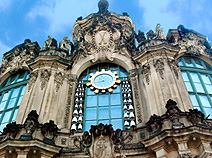 The
Zwinger combines the architecture and art of Dresden’s royal
Baroque past in one magnificent package marked by its famous Crown
Gate. Designed by architect Matthäus
Daniel Pöppelmann with sculptures by Balthasar Permoser and constructed
on the site of the former defensive grounds of the old city castle,
the Zwinger was originally built for Friedrich August, the Elector
of Saxony
called “The Strong” on his gaining the crown of Poland
(see Zwinger
Baroque Palace). Never fully completed according to the
full plan the Zwinger was first
presented
to the court for a royal wedding to the daughter of the Emperor in
1719. The Saxony royal family, starting with August II were great collectors
of art, first exhibited crammed in the Johanneum which now houses the
Transport Museum (see Dresden
Transport Museum), but by the 19th Century
needed larger showplace. In 1855, the Semperbau or Semper building
wing designed by Gottfried Semper was added to the Zwinger, facing
the Elbe
River, to coincide with the opening of the Semperoper. The Semper wing
houses three of the grand museums of the Saxony royals, Porcelain,
Armor and Old Masters.
The
Zwinger combines the architecture and art of Dresden’s royal
Baroque past in one magnificent package marked by its famous Crown
Gate. Designed by architect Matthäus
Daniel Pöppelmann with sculptures by Balthasar Permoser and constructed
on the site of the former defensive grounds of the old city castle,
the Zwinger was originally built for Friedrich August, the Elector
of Saxony
called “The Strong” on his gaining the crown of Poland
(see Zwinger
Baroque Palace). Never fully completed according to the
full plan the Zwinger was first
presented
to the court for a royal wedding to the daughter of the Emperor in
1719. The Saxony royal family, starting with August II were great collectors
of art, first exhibited crammed in the Johanneum which now houses the
Transport Museum (see Dresden
Transport Museum), but by the 19th Century
needed larger showplace. In 1855, the Semperbau or Semper building
wing designed by Gottfried Semper was added to the Zwinger, facing
the Elbe
River, to coincide with the opening of the Semperoper. The Semper wing
houses three of the grand museums of the Saxony royals, Porcelain,
Armor and Old Masters.
Old Masters Picture Gallery – Gemäldegalerie Alte Meister
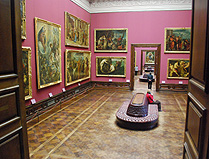 Much
of the art work which forms the incredible collection of the Zwinger
Old Masters Gallery were gathered in a period of just over
half a century.
Starting with August II, "the Strong" and continued after his father’s
death by August III, purchasing agents of the Saxony Electors spread
out over Europe on a buying spree of art, acquiring masterpieces
of the Renaissance
to the 17th and 18th centuries. When a young Wolfgang Von Goethe
(see Goethe
House Frankfurt)
viewed the collection while still in the Johanneum he wrote “My
amazement was beyond words” -
and Goethe knew a lot of words. The collection was removed during
the bombing of WWII and following the war, taken to the Soviet Union,
returned
to Dresden with the reconstruction of the Semperbau beginning in
1955, one hundred years after it first opened.
Much
of the art work which forms the incredible collection of the Zwinger
Old Masters Gallery were gathered in a period of just over
half a century.
Starting with August II, "the Strong" and continued after his father’s
death by August III, purchasing agents of the Saxony Electors spread
out over Europe on a buying spree of art, acquiring masterpieces
of the Renaissance
to the 17th and 18th centuries. When a young Wolfgang Von Goethe
(see Goethe
House Frankfurt)
viewed the collection while still in the Johanneum he wrote “My
amazement was beyond words” -
and Goethe knew a lot of words. The collection was removed during
the bombing of WWII and following the war, taken to the Soviet Union,
returned
to Dresden with the reconstruction of the Semperbau beginning in
1955, one hundred years after it first opened.
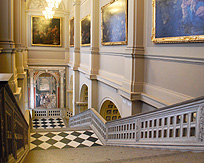 Now
displayed in the multi-levels of what seems a palace in itself of
great marble stairways and halls of royal scale, the Old Masters
Gallery
of Dresden features a significant collection of the Italian Renaissance,
with major works by Raphael, Botticelli, Tintoretto, Giorgione, Titian,
Correggio and Veronese. The most renowned piece in Dresden is Rafael’s
Sistine Madonna, one of the world’s most famous paintings
which was brought to Dresden from Piacenza in northern
Italy by August III and established the bona fides of the Saxony
collection.
Now
displayed in the multi-levels of what seems a palace in itself of
great marble stairways and halls of royal scale, the Old Masters
Gallery
of Dresden features a significant collection of the Italian Renaissance,
with major works by Raphael, Botticelli, Tintoretto, Giorgione, Titian,
Correggio and Veronese. The most renowned piece in Dresden is Rafael’s
Sistine Madonna, one of the world’s most famous paintings
which was brought to Dresden from Piacenza in northern
Italy by August III and established the bona fides of the Saxony
collection.
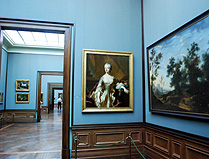 The
collection of 17th-century Dutch and Flemish masters includes several
of major paintings by Rembrandt and his “school”,
as well as van Ruysdael and the great Flemish painters, Rubens, Jordaens
and
Van Dyck. The Dresden collection holds two of only 30 known paintings
by Johannes Vermeer. The 16th Century art is focused on works by
both Lucas Cranach the Older and Cranach the Younger, with
enumerable
portraits of monarchs as well as of Martin
Luther and Philipp Melanchthon (see Martin
Luther’s
Church Doors),
along with works of Jan van Eyck, Dürer, and Hans Holbein.
The
collection of 17th-century Dutch and Flemish masters includes several
of major paintings by Rembrandt and his “school”,
as well as van Ruysdael and the great Flemish painters, Rubens, Jordaens
and
Van Dyck. The Dresden collection holds two of only 30 known paintings
by Johannes Vermeer. The 16th Century art is focused on works by
both Lucas Cranach the Older and Cranach the Younger, with
enumerable
portraits of monarchs as well as of Martin
Luther and Philipp Melanchthon (see Martin
Luther’s
Church Doors),
along with works of Jan van Eyck, Dürer, and Hans Holbein.
Porcelain Collection – Porzellansammlung
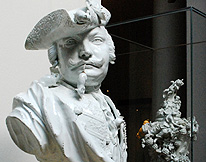 Dresden is famous for its porcelain, with the development of the European
hard paste ceramic porcelain process in 1708 by Johann Friedrich Böttger
and Ehrenfried Walther von Tschirnhaus in the town of Meissen. The
Elector, August the Strong became passionate about the art form, which
he called “white gold” and establish the court manufacture
works in Meissen in 1710. The collection porcelain at the Zwinger is
one of the largest and most stunning in the world with its examples
of early Meissen porcelain as well as oriental ceramic from the 17th
and 18th Centuries. In the hall of animals, lions and peacocks mingle
with dogs and monkeys surrounding a golden pagoda. Fascinating human
figures, like the burgomeister with a mouse in his teeth rather than
a pipe, and a wedding party of porcelain which nearly fills an entire
room.
Dresden is famous for its porcelain, with the development of the European
hard paste ceramic porcelain process in 1708 by Johann Friedrich Böttger
and Ehrenfried Walther von Tschirnhaus in the town of Meissen. The
Elector, August the Strong became passionate about the art form, which
he called “white gold” and establish the court manufacture
works in Meissen in 1710. The collection porcelain at the Zwinger is
one of the largest and most stunning in the world with its examples
of early Meissen porcelain as well as oriental ceramic from the 17th
and 18th Centuries. In the hall of animals, lions and peacocks mingle
with dogs and monkeys surrounding a golden pagoda. Fascinating human
figures, like the burgomeister with a mouse in his teeth rather than
a pipe, and a wedding party of porcelain which nearly fills an entire
room.
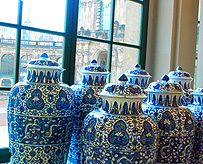 The items on display in the glass windowed curved galleries and mirrored
halls of the Chimes Pavilion come from the collection of 20,000 pieces,
displayed against the backdrop of the Baroque Zwinger courtyard and
garden. The spectrum of examples range from vases dating from the Chinese
Ming
Dynasty, the famed Dragoon Vases, traded for soldiers, delicate from
the halls of the Japanese Emperor Kakiemon brought to Saxony by traders
of the Dutch East India company, to elegant porcelain birds designed
by the Meissen master Johann Joachim Kaendler, the sculptors assistant
who rose to be Meissen’s most famous artist.
The items on display in the glass windowed curved galleries and mirrored
halls of the Chimes Pavilion come from the collection of 20,000 pieces,
displayed against the backdrop of the Baroque Zwinger courtyard and
garden. The spectrum of examples range from vases dating from the Chinese
Ming
Dynasty, the famed Dragoon Vases, traded for soldiers, delicate from
the halls of the Japanese Emperor Kakiemon brought to Saxony by traders
of the Dutch East India company, to elegant porcelain birds designed
by the Meissen master Johann Joachim Kaendler, the sculptors assistant
who rose to be Meissen’s most famous artist.
Armory Museum - Rüstkammer
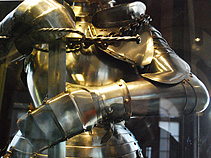 The
armory collection in Dresden begins in the 15th Century when Albert
the Bold began displaying personal and ceremonial weapons
in the ducal
armory chamber of the palace. In 1715, King Louis XIV of France sent
the Elector of Saxony a gift to seal a Treaty of Friendship, six
Spanish horses dressed with caparisons and harnesses and six pairs
of exquisite
pistols of blued barrels and gold inlays in the halters.
The
armory collection in Dresden begins in the 15th Century when Albert
the Bold began displaying personal and ceremonial weapons
in the ducal
armory chamber of the palace. In 1715, King Louis XIV of France sent
the Elector of Saxony a gift to seal a Treaty of Friendship, six
Spanish horses dressed with caparisons and harnesses and six pairs
of exquisite
pistols of blued barrels and gold inlays in the halters.
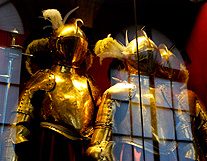 Where to
put this present along with the palace holdings formed the gathering
of the armory collection
found at the Zwinger. Joined
with the medieval armor of the counts of Saxony used for joints and
tournaments,
and armaments gathered
as loot
in military campaigns makes for one of Europe’s most important
collections of ceremonial arms. The collection is now in the east
wing of the Semperbau of the Zwinger, but the intent is to move
it back to
the residence palace when renovations are completed.
Where to
put this present along with the palace holdings formed the gathering
of the armory collection
found at the Zwinger. Joined
with the medieval armor of the counts of Saxony used for joints and
tournaments,
and armaments gathered
as loot
in military campaigns makes for one of Europe’s most important
collections of ceremonial arms. The collection is now in the east
wing of the Semperbau of the Zwinger, but the intent is to move
it back to
the residence palace when renovations are completed.
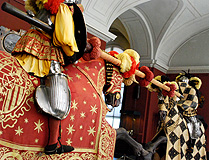 The
focus of the armor exhibition in the Zwinger is on knights, from
courtly hunting to tournaments with full armored horses and mounted
atop rearing steeds flowing with the Saxony colors and the lance
charge. Court
armorers, gunsmiths and goldsmiths added pure artistic designs
to the royal stores of practical weaponry so that elegant armor
of gilt
steel
and gold, fine engraved swords and early gunpowder weapons of intricate
design fill the display cases. The collection houses over a thousand
pieces of clothing and armament from all corners of Europe (see Habsburg Armor Collection Vienna).
The
focus of the armor exhibition in the Zwinger is on knights, from
courtly hunting to tournaments with full armored horses and mounted
atop rearing steeds flowing with the Saxony colors and the lance
charge. Court
armorers, gunsmiths and goldsmiths added pure artistic designs
to the royal stores of practical weaponry so that elegant armor
of gilt
steel
and gold, fine engraved swords and early gunpowder weapons of intricate
design fill the display cases. The collection houses over a thousand
pieces of clothing and armament from all corners of Europe (see Habsburg Armor Collection Vienna).
Visiting Zwinger Museums
The Museums
of the Zwinger - Old Masters, Armory and the Porcelain Gallery can
be visited with a single combined admission
ticket for €10,
or individually for €3. They are included in the Dresden Card and
City Museum Card. The Zwinger Museums also usually includes the Royal
Mathematical and Physical Instruments collection (Mathematisch-Physikalischer
Salon), which is currently closed for construction. © Bargain
Travel Europe
Find
best hotel and vacation deals in Dresden
on TripAdvisor
Web Info
Semperbau
Museums
These articles are copyrighted and the sole property of Bargain Travel Europe and WLPV, LLC. and may not be copied or reprinted without permission.
See Also:
FRAUENKIRCHE "OUR LADY" DRESDEN
SOPHIENKELLER - BAROQUE THEME RESTAURANT
SLEEPER TRAIN - DRESDEN TO ZURICH
TWO TOURS FOR FALL - DRESDEN - MUNICH
MORITZBURG BAROQUE SUMMER PALACE
CHARLOTTENBURG PALACE - BERLIN


